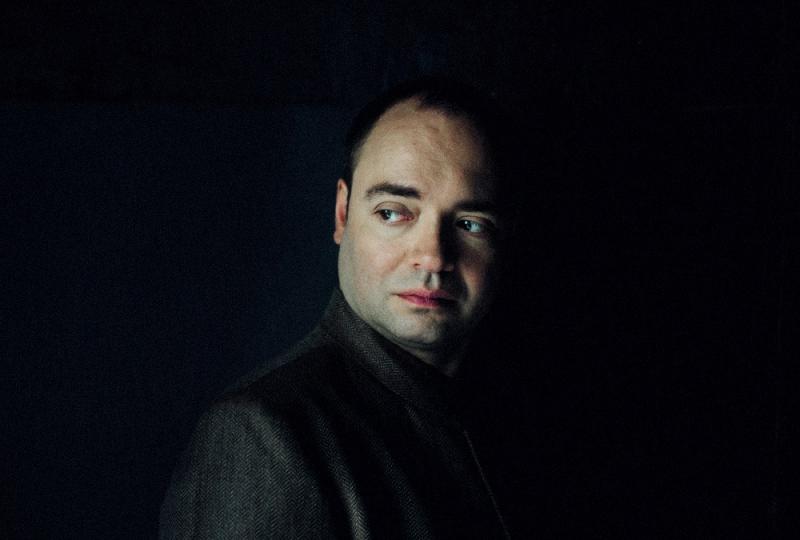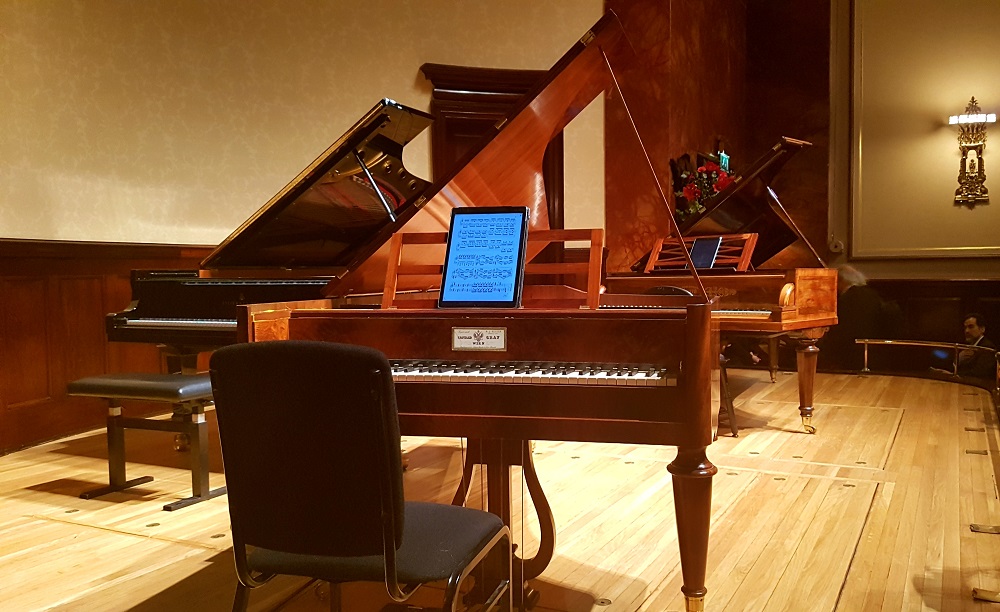Alexander Melnikov, Wigmore Hall review - three pianos, four monsterworks | reviews, news & interviews
Alexander Melnikov, Wigmore Hall review - three pianos, four monsterworks
Alexander Melnikov, Wigmore Hall review - three pianos, four monsterworks
Crazy programme taxes even this Russian master of orchestral pianism

Living-museum recitals on a variety of historic instruments pose logistical problems. Telling The Arts Desk about his award-nominated CD of mostly 19th-century works for horns and pianos, Alec Frank-Gemmill remarked on the near-impossibility of reproducing the experiment in the concert-hall: playing on four period horns would need several intervals, and colleague Alasdair Beatson would hardly be likely to have the four pianos in the same room.
Perhaps it did, but not in such a good way; there was nothing to match Rabinovich's revelation of Chopin Ballades on the composer's beloved Pleyel. Melnikov has proved something of a marathon man, excelling in both books of Debussy's Preludes on the Wigmore Hall's Steinway D back in April 2017. His sensitivities have been well proven in partnerships with great musicians like Isabelle Faust. Yet here he chose four daunting epics of the piano repertoire which would be unlikely to make a satisfying programme under any circumstances other than a supreme ease in making the difficult seem easy - the coolness of a Hamelin, for instance.
The limitations of a replica and an old instrument, however well maintained, in tackling such monsters only offered further obstacles (pictured below by David Thompson: Graf model in foreground, Erard behind, Steinway to the left). Surely Schubert, in composing the "Wanderer" Fantasy, was thinking of the full range of sonorities of a piano not yet invented (rather like Beethoven in the "Hammerklavier" Sonata). The copy of an 1824 Viennese Graf fortepiano, one of two instruments on loan from the Edwin Beunk Collection in the Netherlands, allowed for some crisp articulation, with a fresh spring to the opening summons, and Melnikov just about got round the difficulty of making a singing line from the treble in the central Adagio variations on the song which gives the work its soubriquet. But there was some surprising mud in the most virtuosic moments.  Was this just Melnikov pushing too hard on an instrument which seems to favour introspection, the sound tending to go inwards? He certainly gave some of Chopin's Op, 10 Études a hammering, and the move to an 1837 Erard from Paris - Chopin's preference for a "bad day", while he thought Pleyel always served him well on a good one - felt to me a bit like putting earplugs in halfway, with cowled sonorities other than at the very extremes of the keyboard.
Was this just Melnikov pushing too hard on an instrument which seems to favour introspection, the sound tending to go inwards? He certainly gave some of Chopin's Op, 10 Études a hammering, and the move to an 1837 Erard from Paris - Chopin's preference for a "bad day", while he thought Pleyel always served him well on a good one - felt to me a bit like putting earplugs in halfway, with cowled sonorities other than at the very extremes of the keyboard.
That meant the champagne bubbles of the more extrovert Études never quite rose to the surface. And, ma foi, was Melnikov fast. Usually he gives just enough articulation and breathing space to speedier tempi, but there still weren't quite enough as one tried to adjust to the usually radiant E major Lento ma non troppo at a pushed Andante. The central juggernaut threatening destruction certainly sounded novel. So did the cascades of the more brilliant Études, delivered at what may have been a record velocity, and at least the "Revolutionary" clincher, No. 12 in C minor, had space and proper contour.
Even so, this never felt comfortable in a good way for long, and while Liszt's Réminiscences de Don Juan after the interval - also on the Erard - started majestically with a thunderous treatment of Mozart's statue music and sparkled in the first few variations on "La ci darem", the rushing soon became too approximate for comfort.
By now we were feeling the need for a poetic breather, but the fireworks just kept going off in the first and third of Stravinsky's Three Movements from Petrushka (potentially a good companion, the final tableau borrowing from Russian street tunes just as Liszt takes several of Mozart's most popular melodies). Big bass richness in something the Steinway does best amplified the whole picture, but in his interesting observations during a pre-concert event, Melnikov pointed out that Steinways were geared towards big names like Rachmaninov playing in big halls, and possibly not ideal for a venue like the Wigmore (note - over at St John's Smith Square, Anna Fedorova was demonstrating the possibilities of the much under-used Blüthner grand).
So we felt hammered, with a smattering of approximate hits. The Chopin encore brought balm, but what a shame there hadn;t been more of that throughout a programme of way too many notes. Melnikov, an honest fellow, expressed possible misgivings in the talk about what he was about to attempt. He will probably accept now that the experiment didn't quite come off, adjusting for the future accordingly.
rating
Share this article
The future of Arts Journalism
You can stop theartsdesk.com closing!
We urgently need financing to survive. Our fundraising drive has thus far raised £49,000 but we need to reach £100,000 or we will be forced to close. Please contribute here: https://gofund.me/c3f6033d
And if you can forward this information to anyone who might assist, we’d be grateful.

Subscribe to theartsdesk.com
Thank you for continuing to read our work on theartsdesk.com. For unlimited access to every article in its entirety, including our archive of more than 15,000 pieces, we're asking for £5 per month or £40 per year. We feel it's a very good deal, and hope you do too.
To take a subscription now simply click here.
And if you're looking for that extra gift for a friend or family member, why not treat them to a theartsdesk.com gift subscription?
more Classical music
 Kilsby, Parkes, Sinfonia of London, Wilson, Barbican review - string things zing and sing in expert hands
British masterpieces for strings plus other-worldly tenor and horn - and a muscular rarity
Kilsby, Parkes, Sinfonia of London, Wilson, Barbican review - string things zing and sing in expert hands
British masterpieces for strings plus other-worldly tenor and horn - and a muscular rarity
 From Historical to Hip-Hop, Classically Black Music Festival, Kings Place review - a cluster of impressive stars for the future
From quasi-Mozartian elegance to the gritty humour of a kitchen inspection
From Historical to Hip-Hop, Classically Black Music Festival, Kings Place review - a cluster of impressive stars for the future
From quasi-Mozartian elegance to the gritty humour of a kitchen inspection
 Shibe, LSO, Adès, Barbican review - gaudy and glorious new music alongside serene Sibelius
Adès’s passion makes persuasive case for the music he loves, both new and old
Shibe, LSO, Adès, Barbican review - gaudy and glorious new music alongside serene Sibelius
Adès’s passion makes persuasive case for the music he loves, both new and old
 Anja Mittermüller, Richard Fu, Wigmore Hall review - a glorious hall debut
The Austrian mezzo shines - at the age of 22
Anja Mittermüller, Richard Fu, Wigmore Hall review - a glorious hall debut
The Austrian mezzo shines - at the age of 22
 First Person: clarinettist Oliver Pashley on the new horizons of The Hermes Experiment's latest album
Compositions by members of this unusual quartet feature for the first time
First Person: clarinettist Oliver Pashley on the new horizons of The Hermes Experiment's latest album
Compositions by members of this unusual quartet feature for the first time
 Gesualdo Passione, Les Arts Florissants, Amala Dior Company, Barbican review - inspired collaboration excavates the music's humanity
At times it was like watching an anarchic religious procession
Gesualdo Passione, Les Arts Florissants, Amala Dior Company, Barbican review - inspired collaboration excavates the music's humanity
At times it was like watching an anarchic religious procession
 Classical CDs: Camels, concrete and cabaret
An influential American composer's 90th birthday box, plus British piano concertos and a father-and-son duo
Classical CDs: Camels, concrete and cabaret
An influential American composer's 90th birthday box, plus British piano concertos and a father-and-son duo
 Cockerham, Manchester Camerata, Sheen, Martin Harris Centre, Manchester review - re-enacting the dawn of modernism
Two UK premieres added to three miniatures from a seminal event of January 1914
Cockerham, Manchester Camerata, Sheen, Martin Harris Centre, Manchester review - re-enacting the dawn of modernism
Two UK premieres added to three miniatures from a seminal event of January 1914
 Kempf, Brno Philharmonic, Davies, Bridgewater Hall, Manchester review - European tradition meets American jazz
Bouncing Czechs enjoy their Gershwin and Brubeck alongside Janáček and Dvořák
Kempf, Brno Philharmonic, Davies, Bridgewater Hall, Manchester review - European tradition meets American jazz
Bouncing Czechs enjoy their Gershwin and Brubeck alongside Janáček and Dvořák
 Solomon, OAE, Butt, QEH review - daft Biblical whitewashing with great choruses
Even a top soprano and mezzo can’t make this Handel paean wholly convincing
Solomon, OAE, Butt, QEH review - daft Biblical whitewashing with great choruses
Even a top soprano and mezzo can’t make this Handel paean wholly convincing
 Two-Piano Gala, Kings Place review - shining constellations
London Piano Festival curators and illustrious friends entertain and enlighten
Two-Piano Gala, Kings Place review - shining constellations
London Piano Festival curators and illustrious friends entertain and enlighten
 Echo Vocal Ensemble, Latto, Union Chapel review - eclectic choral programme garlanded with dance
Beautiful singing at the heart of an imaginative and stylistically varied concert
Echo Vocal Ensemble, Latto, Union Chapel review - eclectic choral programme garlanded with dance
Beautiful singing at the heart of an imaginative and stylistically varied concert

Add comment